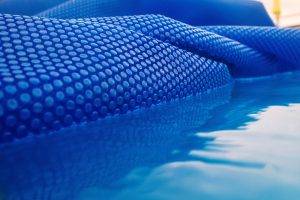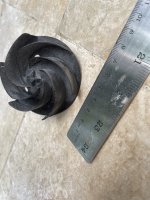Hello community,
One more noob here, DIY'er by spirit and first-time pool owner.
Need advice on the lubiraction of mechanical seal, per thread subject.
Also, an advice about proper tightening of the same thing would be nice as well.
Here's the history and details to give an idea of condition and environment:
I bought a Bestway Flowclear 24'x12'x4' oval pool (~6,000gal) with sand filter in Costco this year summer, installed and used it very lightly (once a week or less), but kept the sand filter running most of the time until last month. The water was initially tap, but now likely mostly rainwater. The pool is under large treeI so I keep it covered to protect from birds goo, and drop a 3" chlorinating pill about every week,into the strainer basket.
The sand filter is 1500 GPM / 0.47 HP / 1.5" pipe pump, model 58498E (this one).
Due to my own sloppiness and carelessness, I abused (overloaded + under-primed, + clorine-poisoned) the flow system, and eventually the working pressure went up from 5 10 10 psi within a few days. For the last month I only ran the filter during day time, and one day the pump gave a humming sound and did not start. I turned it off, on again, it started but after a few hours I noticed some thick sticky grease, like a tar, in the strainer basket. I thought the pump spewed it off, can't think of anything else.
I powered off the pump, cleaned the basket and pump, incl. pressure chamber, removed the sand (felt like all chlorine and some of that goo, which might caused the PSI go up twice), the impeller was rotating easily and the motor appeared alive, but as I tried to figure out where the grease came from, and where to refill it, I took the whole thing apart, completely, to the last bolt, except for the motor itself, so I learned a lot abot centrifugal pumps and mechanical seals over this weekend.
The paired surfaces of mechanical seals look like ring mirrors, no visual damage, so I am putting the thing back together.
But I think I need to put some lubricant on mechanical seal surface(s)m right?
And there is no such thing as universal lubricant, there must be something narrowly-suiitable for small pool pumps of this caliber, right?
So... can someone advise the lube -- silicone? teflon? lithium?
Attaching image below to show both surfaces. The outer diameter of rotating seal (on the left) is apprx. 3/4", inner is close to 5/8". If I just put impeller back in place into its chamber, and pour water over, it does not leak out, so I assume the seal is still in decent shape. just needs proper lube?

And if anyone can share any insight, what is that thick black sticky substabce, where it came from and why? One buyer of the same model on Amazon had the same issue, and Bestway had no idea how did that happen...
Thank you for your attention!
-Me
One more noob here, DIY'er by spirit and first-time pool owner.
Need advice on the lubiraction of mechanical seal, per thread subject.
Also, an advice about proper tightening of the same thing would be nice as well.
Here's the history and details to give an idea of condition and environment:
I bought a Bestway Flowclear 24'x12'x4' oval pool (~6,000gal) with sand filter in Costco this year summer, installed and used it very lightly (once a week or less), but kept the sand filter running most of the time until last month. The water was initially tap, but now likely mostly rainwater. The pool is under large treeI so I keep it covered to protect from birds goo, and drop a 3" chlorinating pill about every week,into the strainer basket.
The sand filter is 1500 GPM / 0.47 HP / 1.5" pipe pump, model 58498E (this one).
Due to my own sloppiness and carelessness, I abused (overloaded + under-primed, + clorine-poisoned) the flow system, and eventually the working pressure went up from 5 10 10 psi within a few days. For the last month I only ran the filter during day time, and one day the pump gave a humming sound and did not start. I turned it off, on again, it started but after a few hours I noticed some thick sticky grease, like a tar, in the strainer basket. I thought the pump spewed it off, can't think of anything else.
I powered off the pump, cleaned the basket and pump, incl. pressure chamber, removed the sand (felt like all chlorine and some of that goo, which might caused the PSI go up twice), the impeller was rotating easily and the motor appeared alive, but as I tried to figure out where the grease came from, and where to refill it, I took the whole thing apart, completely, to the last bolt, except for the motor itself, so I learned a lot abot centrifugal pumps and mechanical seals over this weekend.
The paired surfaces of mechanical seals look like ring mirrors, no visual damage, so I am putting the thing back together.
But I think I need to put some lubricant on mechanical seal surface(s)m right?
And there is no such thing as universal lubricant, there must be something narrowly-suiitable for small pool pumps of this caliber, right?
So... can someone advise the lube -- silicone? teflon? lithium?
Attaching image below to show both surfaces. The outer diameter of rotating seal (on the left) is apprx. 3/4", inner is close to 5/8". If I just put impeller back in place into its chamber, and pour water over, it does not leak out, so I assume the seal is still in decent shape. just needs proper lube?

And if anyone can share any insight, what is that thick black sticky substabce, where it came from and why? One buyer of the same model on Amazon had the same issue, and Bestway had no idea how did that happen...
Thank you for your attention!
-Me
Last edited:





